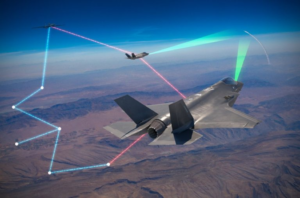 Experimental equipment is paving the way for multi-domain operations. A recent and highly publicized and anticipated test off the coast of Florida in December of 2019 used experimental equipment developed by Lockheed Martin, Northrop Grumman, and Honeywell called “GatewayONE.” It is a radio and antenna system that allows two-way data transfer between an F35 and F22. The Air Force plans on testing GatewayONE on a Kratos XQ-58 Valkrie drone in April of 2020. Oriana Pawlyk of Military.com fills us in on future tests the U.S. Air Force is planning, she writes (abridged):
Experimental equipment is paving the way for multi-domain operations. A recent and highly publicized and anticipated test off the coast of Florida in December of 2019 used experimental equipment developed by Lockheed Martin, Northrop Grumman, and Honeywell called “GatewayONE.” It is a radio and antenna system that allows two-way data transfer between an F35 and F22. The Air Force plans on testing GatewayONE on a Kratos XQ-58 Valkrie drone in April of 2020. Oriana Pawlyk of Military.com fills us in on future tests the U.S. Air Force is planning, she writes (abridged):
The U.S. Air Force plans to conduct additional tests at its combatant commands of a sophisticated data-sharing system that fuses intelligence data from multiple platforms, according to top service officials.
Dr. Will Roper, assistant secretary of the Air Force for acquisition, technology and logistics, and Preston Dunlap, the service’s chief architect for the Advanced Battle Management System (ABMS), explained Tuesday that developers went to U.S. Northern Command first for key tests to see if the military services could execute multi-domain operations by pooling resources.
In one case, it included a highly publicized F-22 Raptor and F-35 Joint Strike Fighter data transfer test, conducted in December off the coast of Florida.
“We did begin to pass data back and forth over what we call a low-probability-of-detection intercept,” said Dunlap, adding that the test involved Air Force fifth-generation fighters and Navy F-35Bs transferring data securely.
Another recent trial at White Sands Missile Range tested two more Lockheed Martin experimental systems, the first was an IBCS kit fitted on two F-35’s, and the second was the Harvest Lightning Ground Station. The two communicated over the F-35’s Multifunction Advanced Data Link (MADL) which allowed the use of the F-35 as an extended airborne sensor for an IBCS live-fire test against multiple targets. Lockheed Martin’s press release on January 21st, 2020 reads:
Two U.S. Air Force F-35s were integrated with the U.S. Army Integrated Air and Missile Defense Battle Command System (IBCS), providing an airborne sensor capability to successfully detect, track and intercept near simultaneous air-breathing threats in a test at White Sands Missile Range, New Mexico. The December 2019 test marked the first time F-35s were used as sensors during an IBCS live fire test against multiple airborne targets.
Linking F-35s to IBCS via the Multifunction Advanced Data Link (MADL) provided enhanced situational awareness and weapons-quality track data to engage airborne targets. The proof of concept demonstration used experimental equipment developed by Lockheed Martin, including the Harvest Lightning Ground Station and IBCS adaptation kit (A-Kit).
“The F-35’s advanced sensors and connectivity enable it to gather, analyze and seamlessly share critical information with the joint fighting force to lead the multi-domain battlespace,” said Greg Ulmer, Lockheed Martin vice president and general manager of the F-35 program. “This test validated the F-35’s capability to serve as an airborne sensor and extend the range of critical Integrated Air and Missile Defense interceptors.”
“This test represents a major milestone for multi-domain operations by leveraging airborne assets to detect and track threats that can then be countered with ground-based effectors. This demonstrates a tremendous capability to defeat threats that are terrain masked or beyond ground-based sensor detection capabilities due to terrain and curvature of the earth,” said Jay Pitman, vice president, Lower Tier Integrated Air and Missile Defense at Lockheed Martin Missiles and Fire Control.
This test is the latest in a series of successful activities to demonstrate the F-35’s role as the keystone of the joint force. Lockheed Martin is evolving technologies that connect, share and learn to create a holistic network that provides unprecedented situational awareness across the battlespace and enables Multi-Domain Operations.



